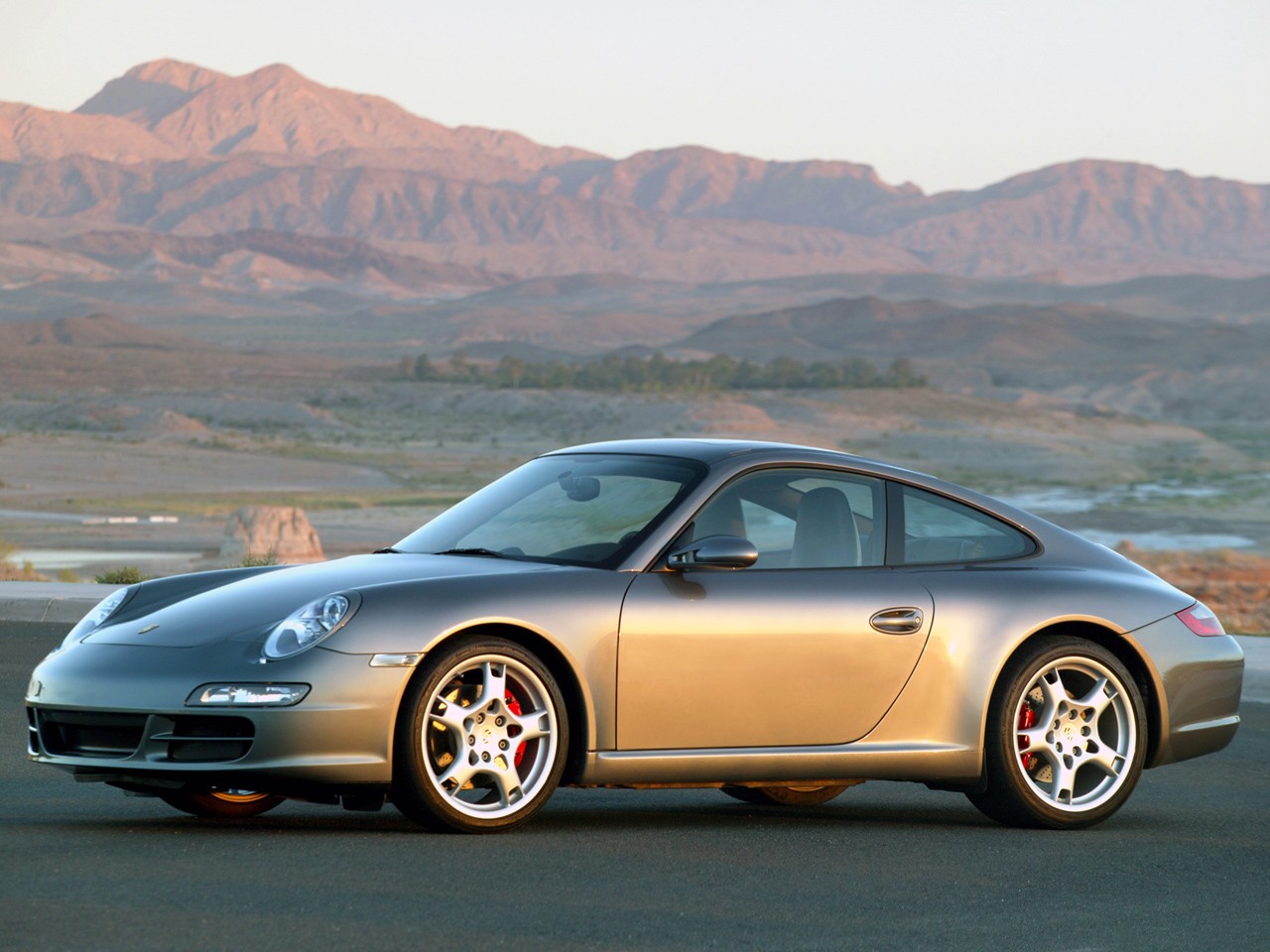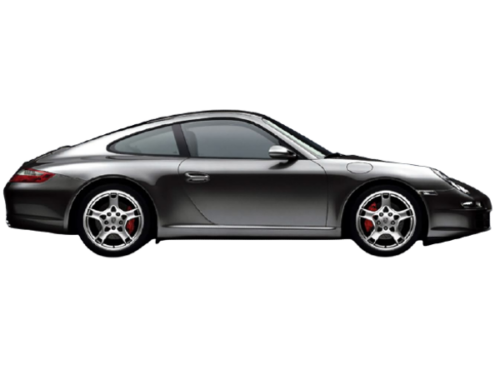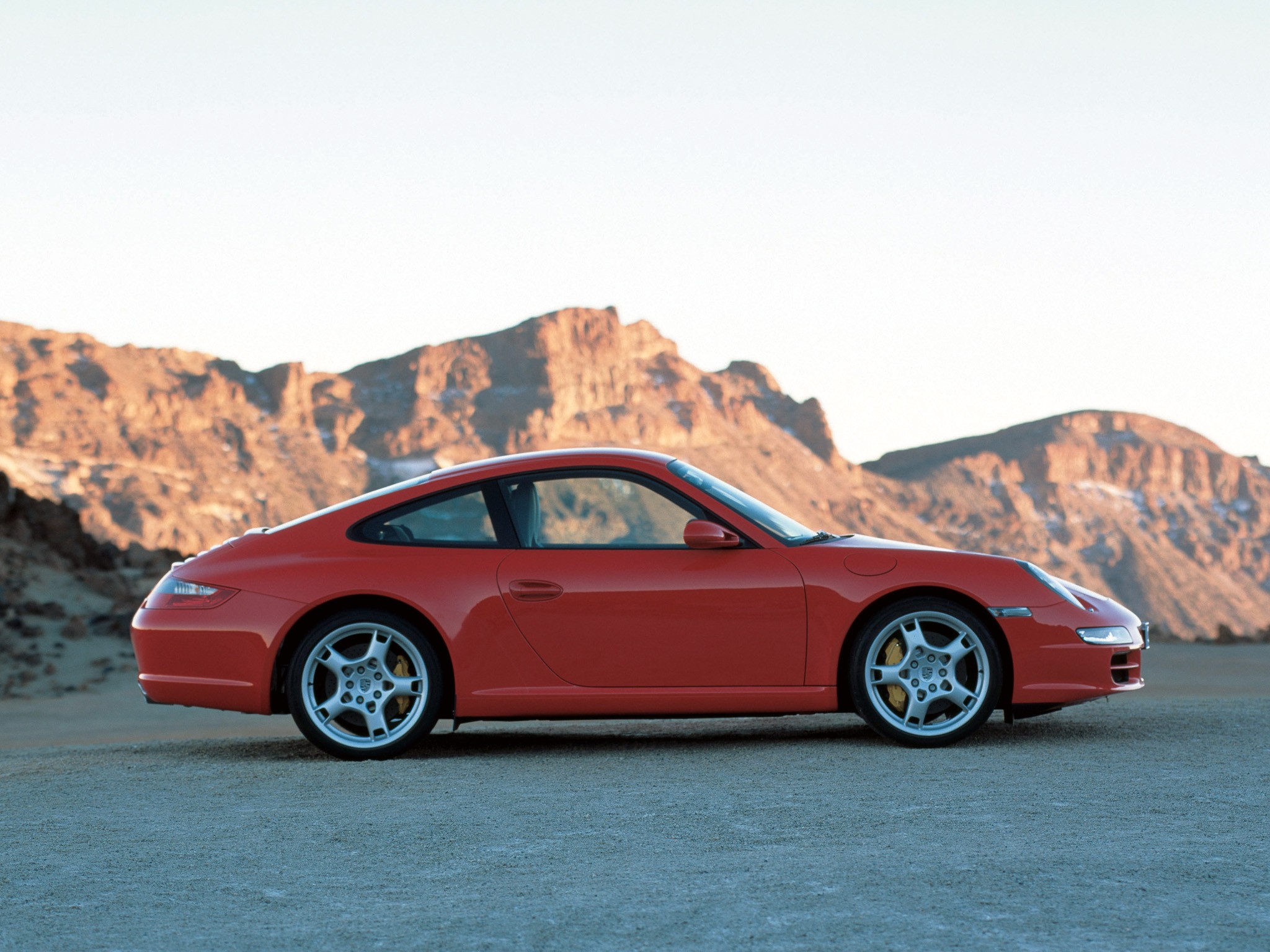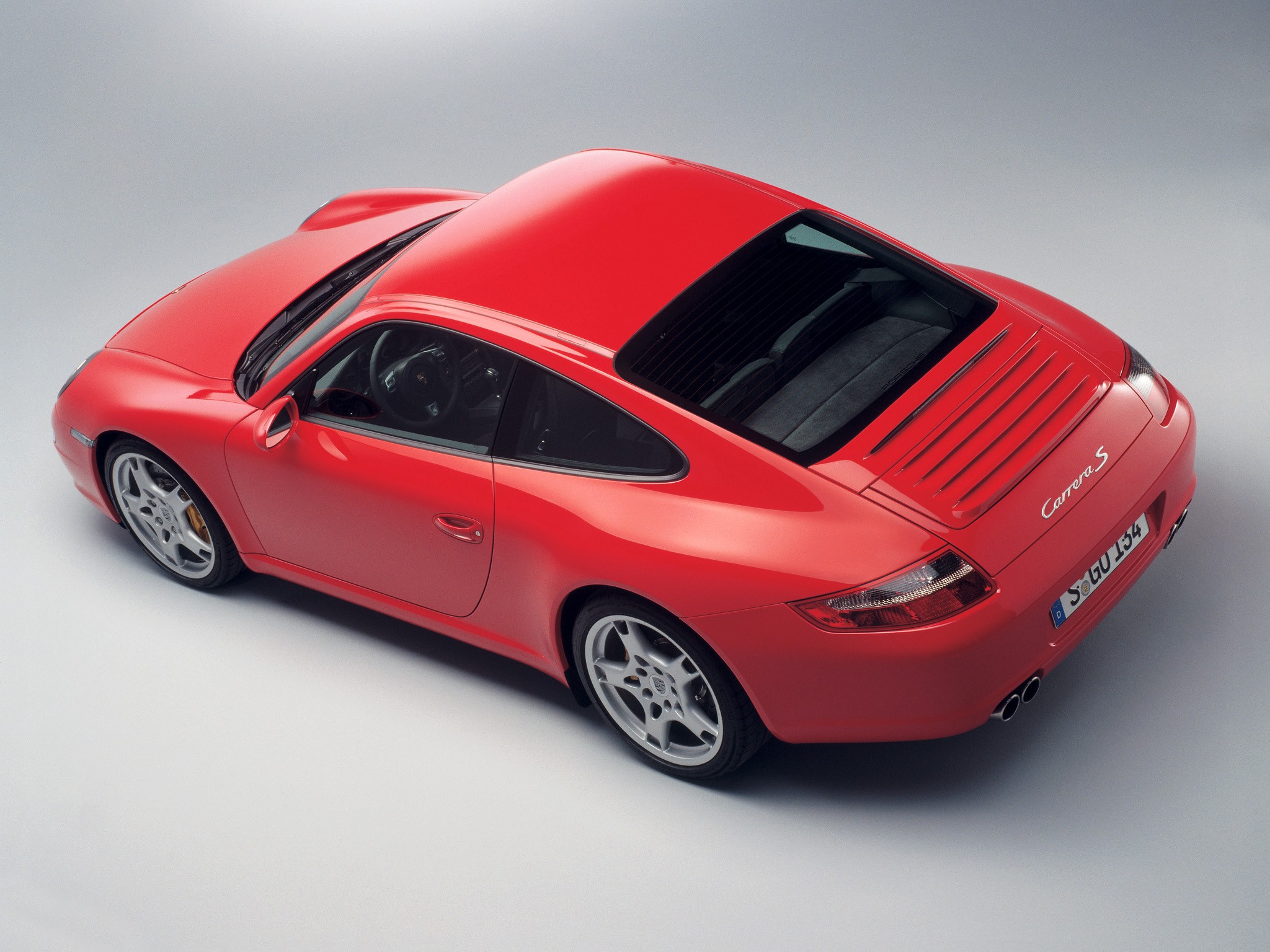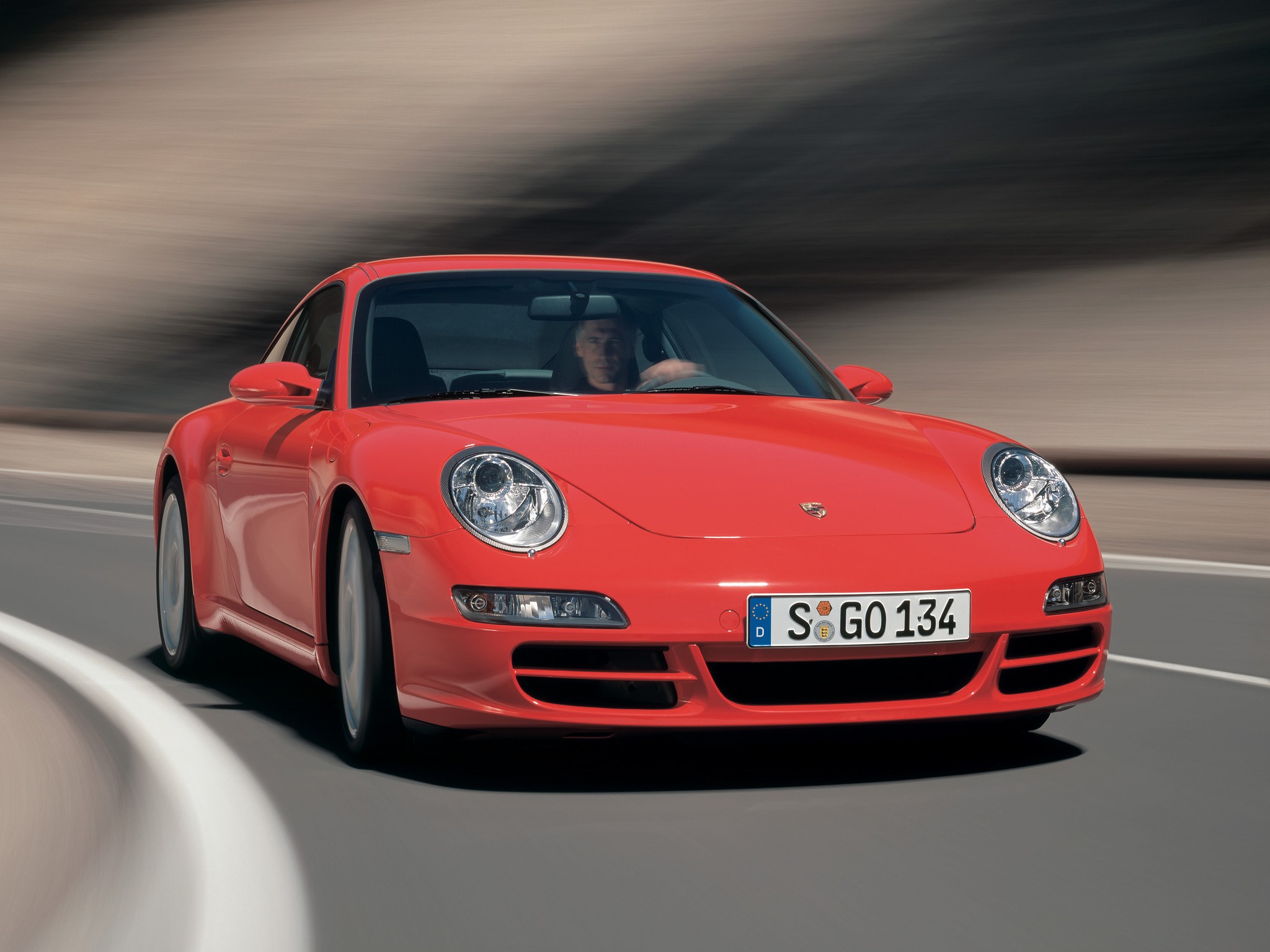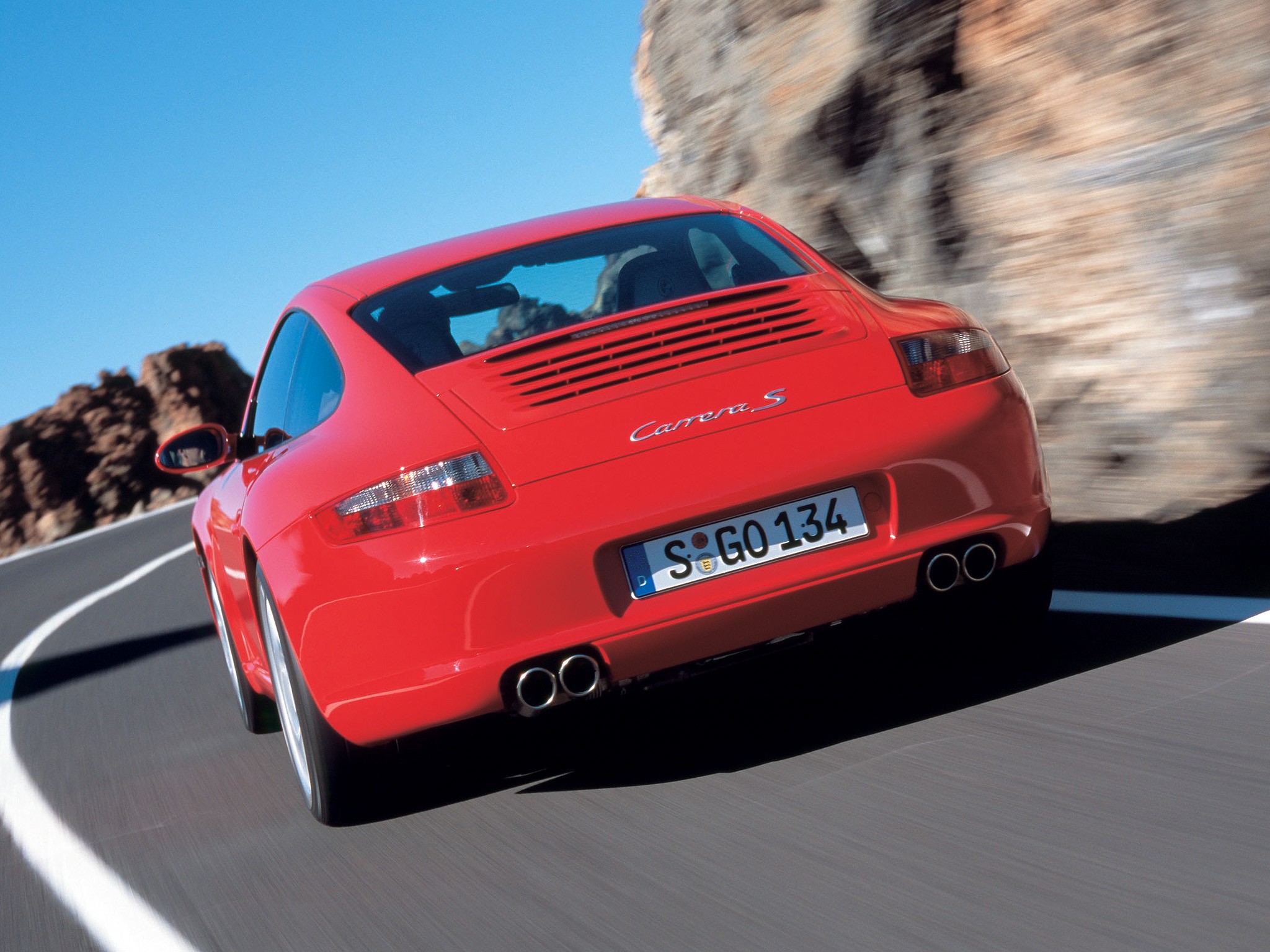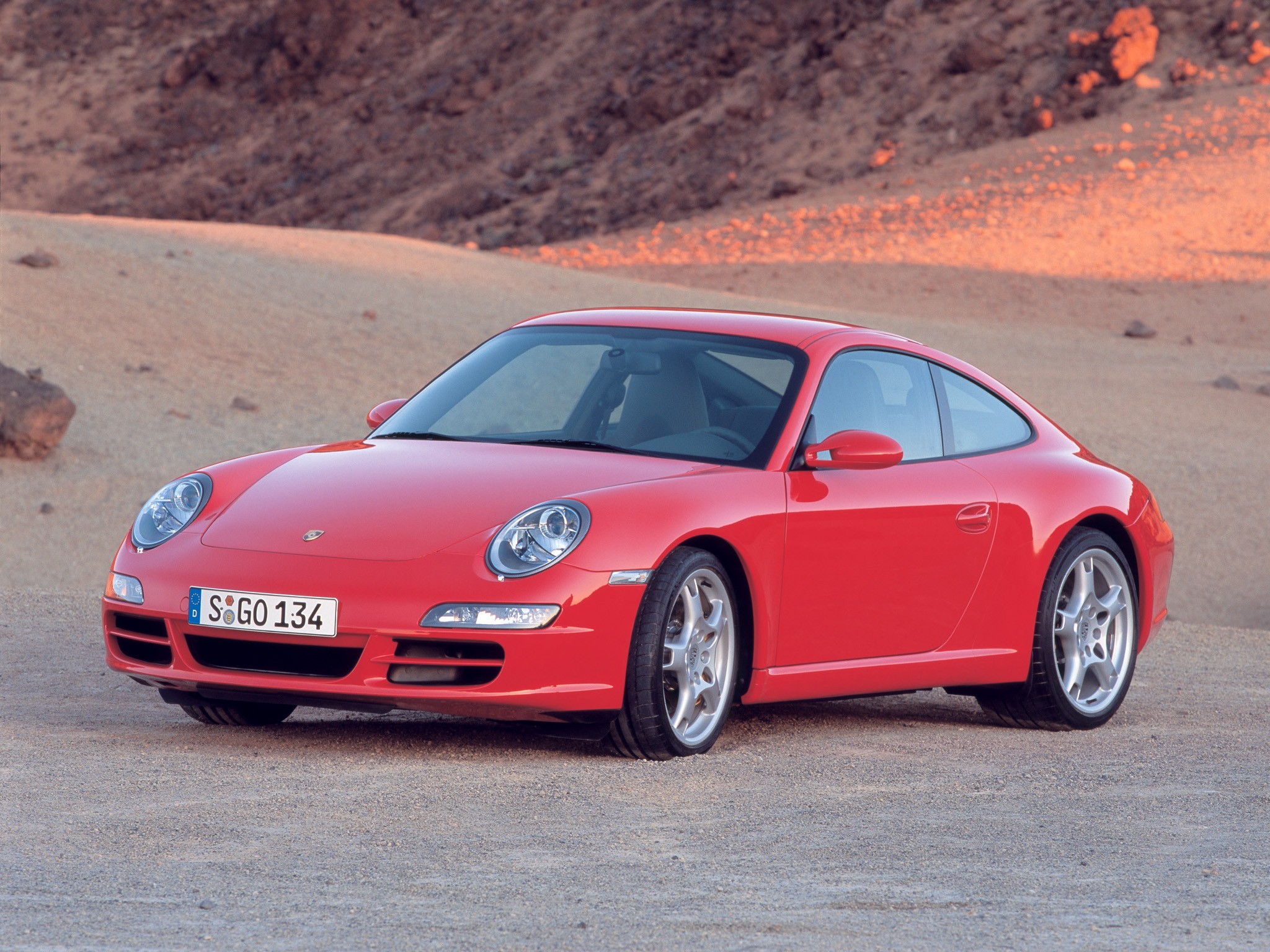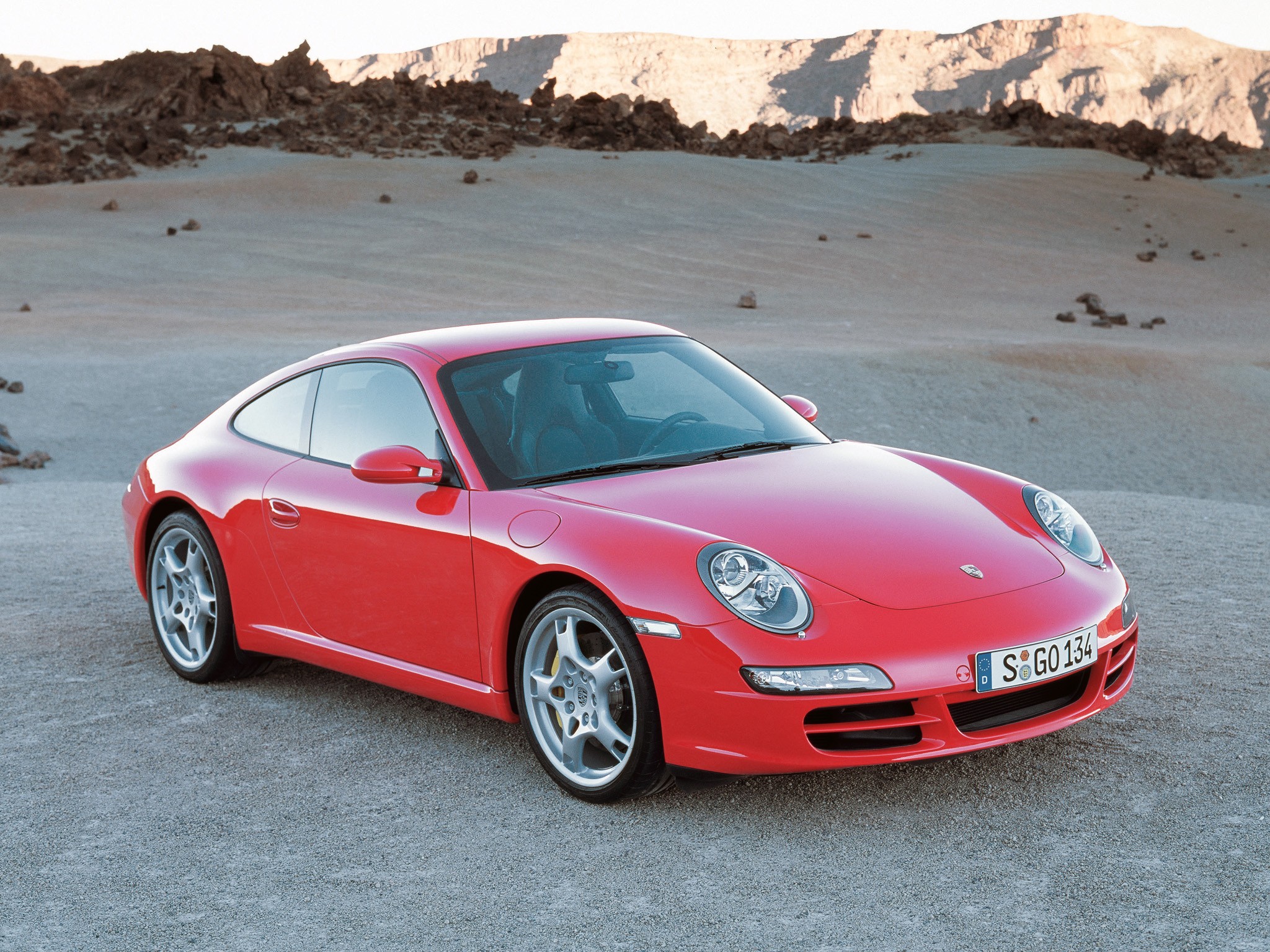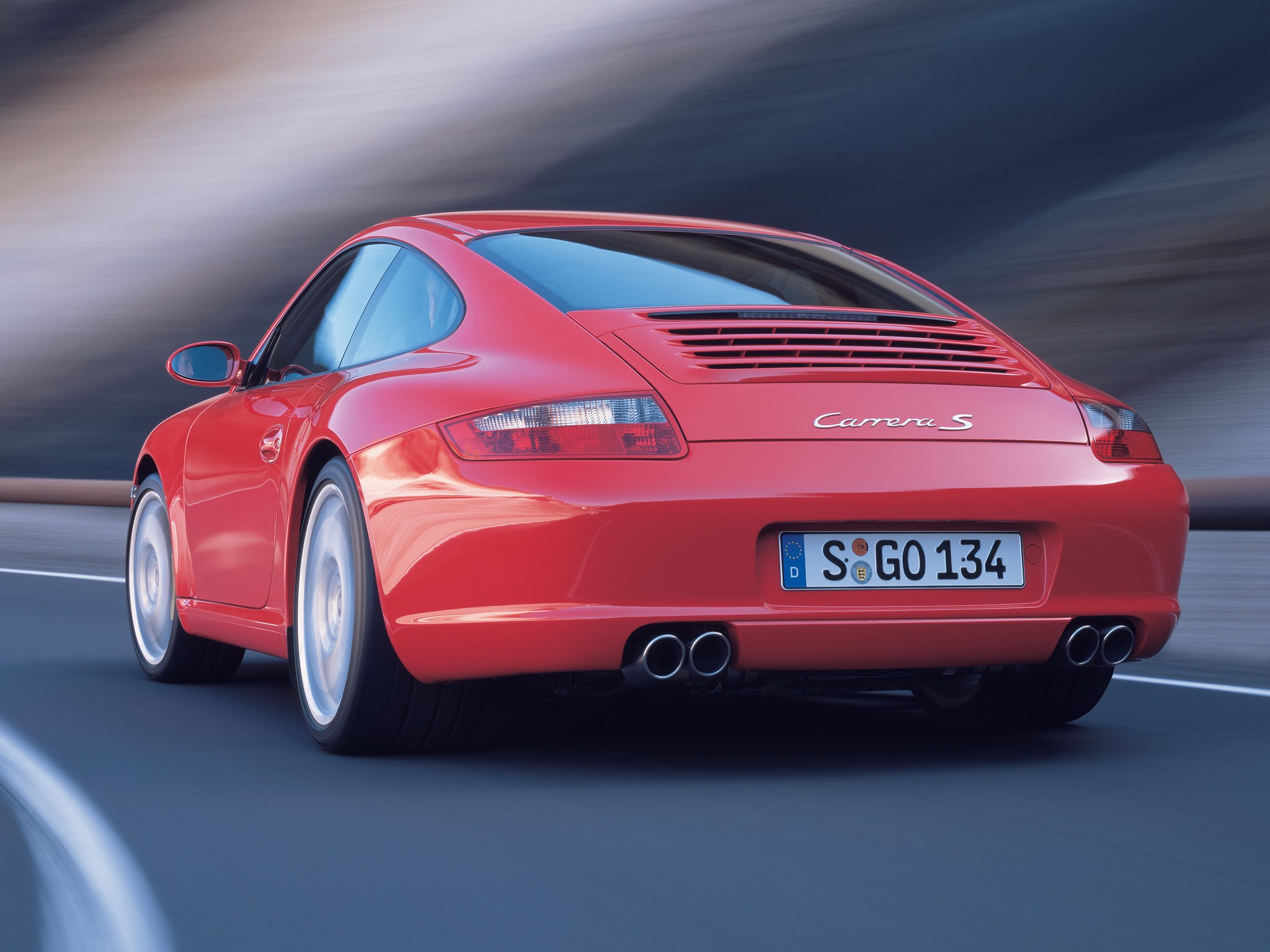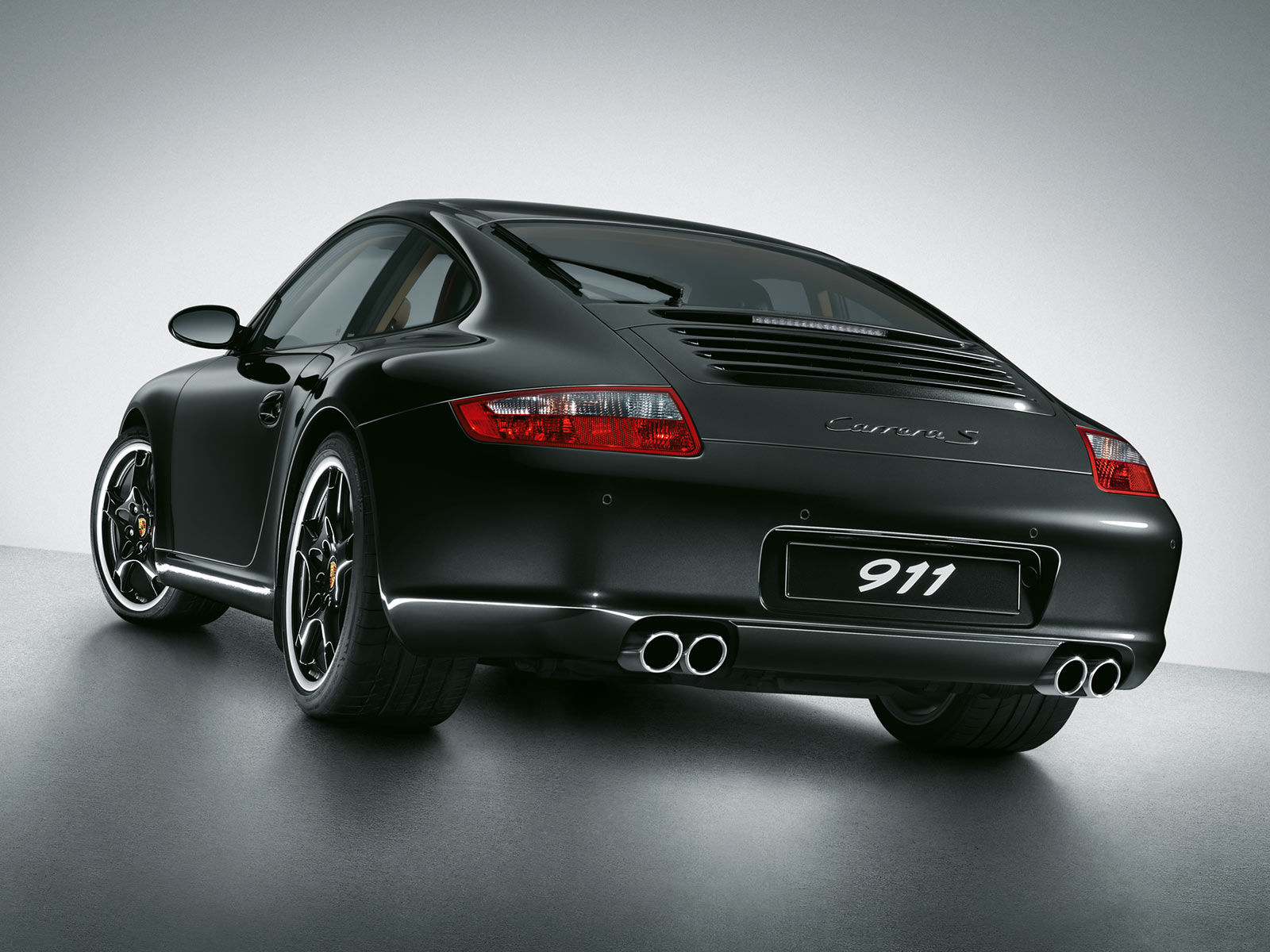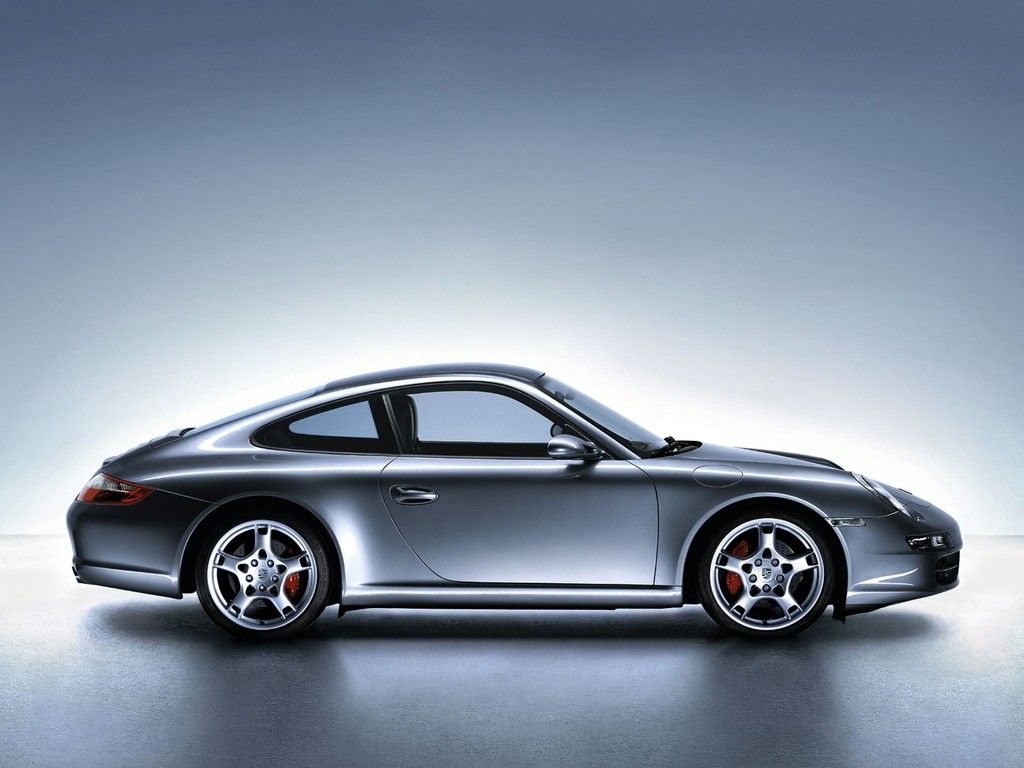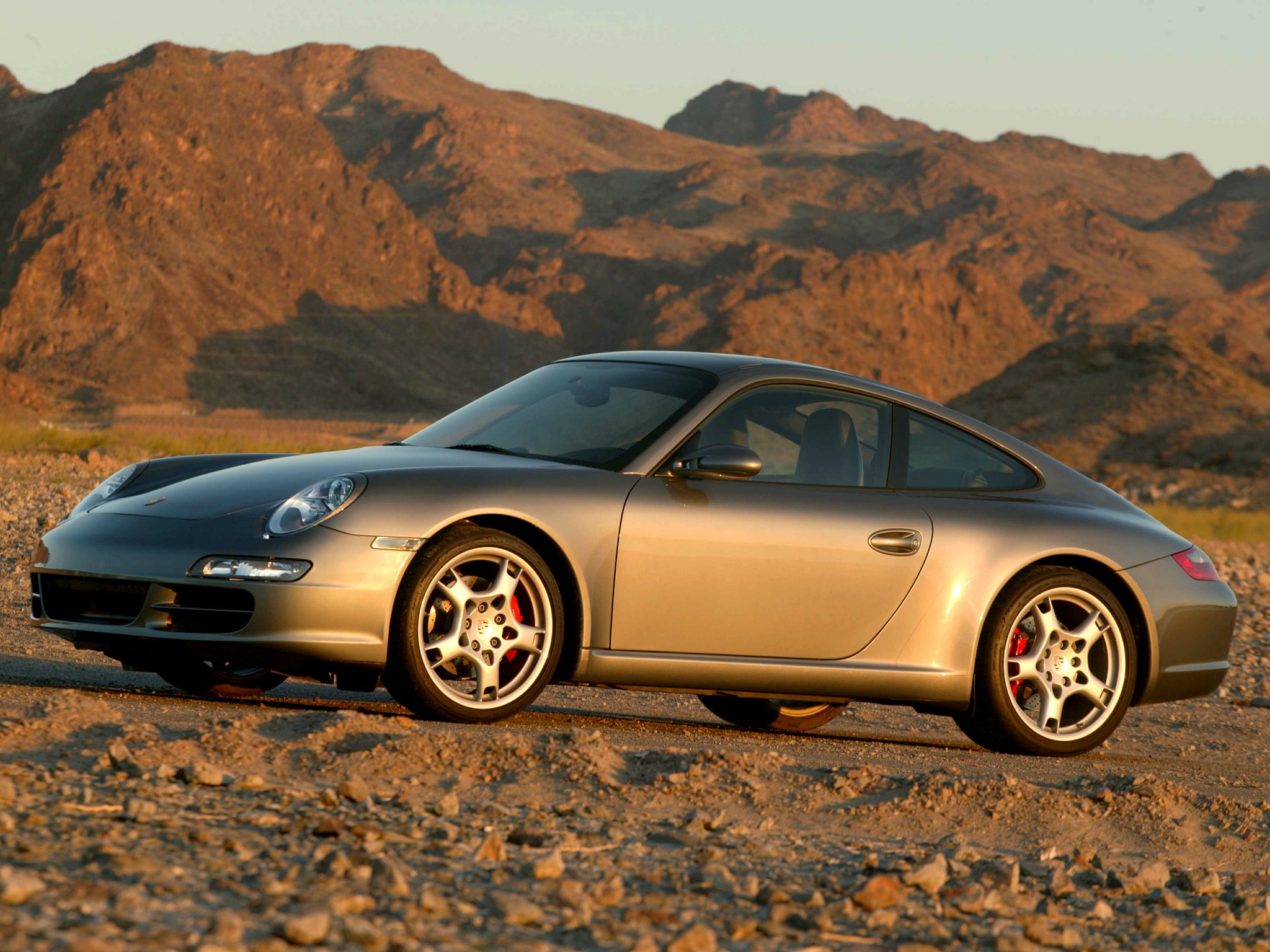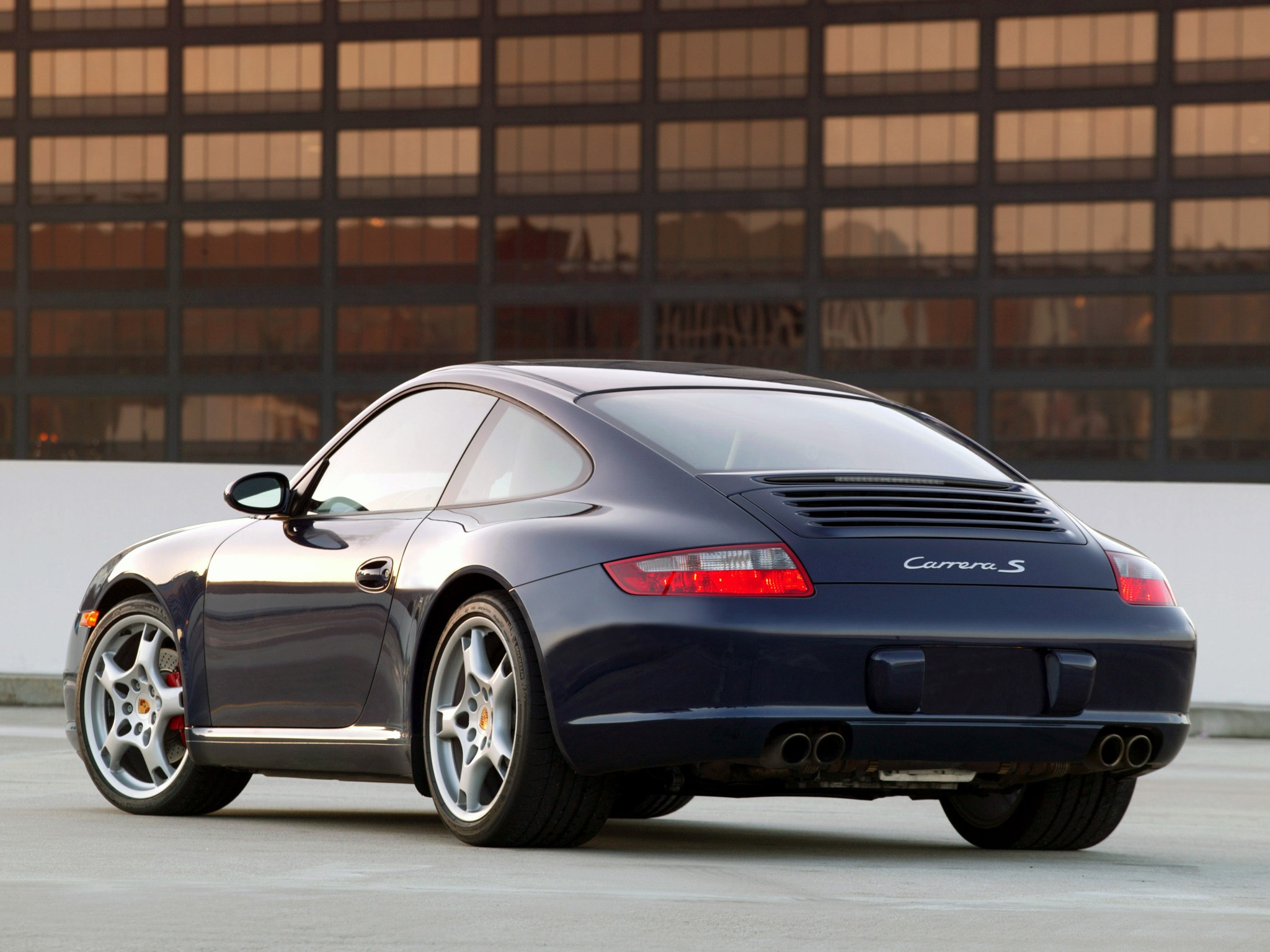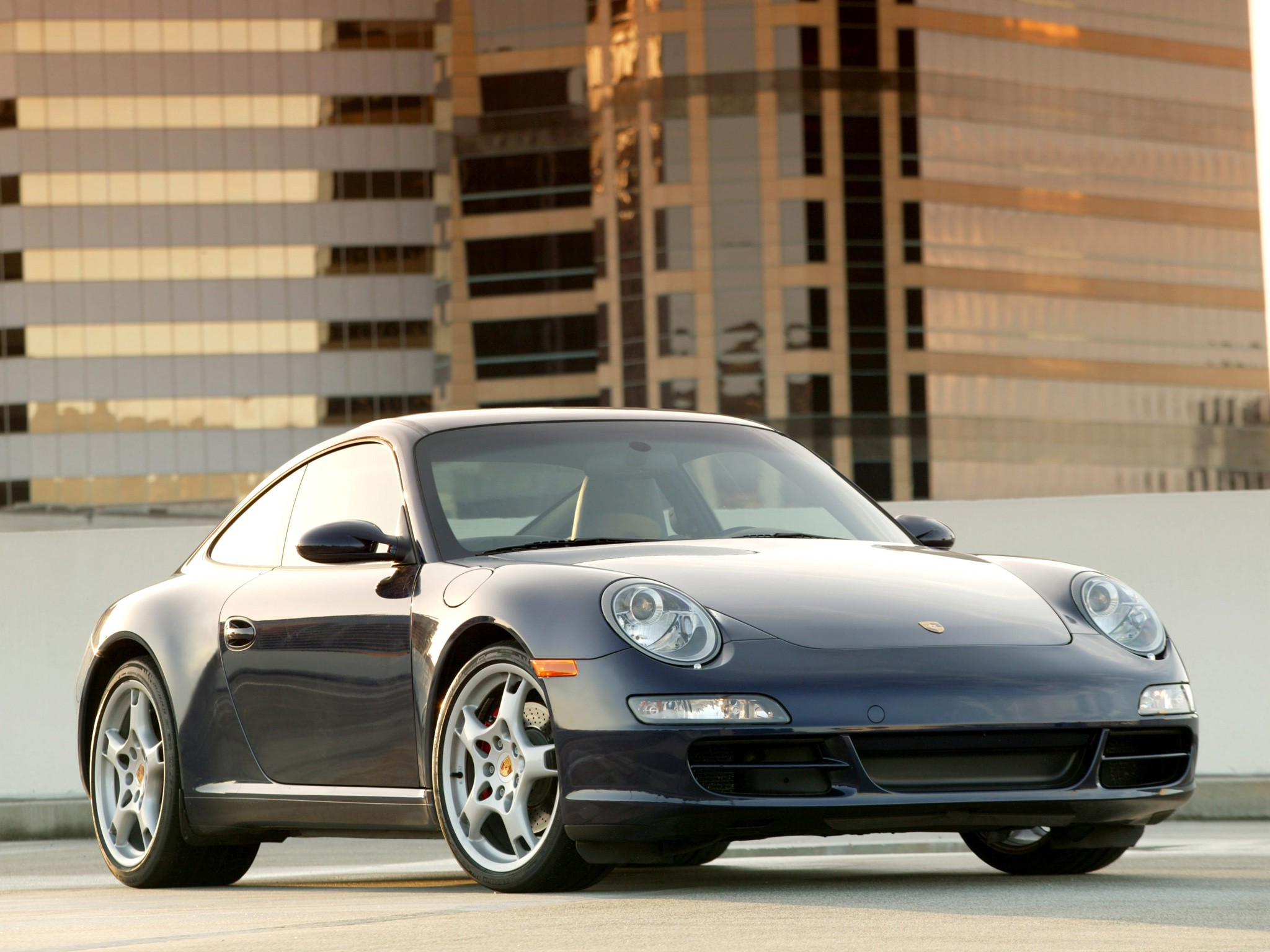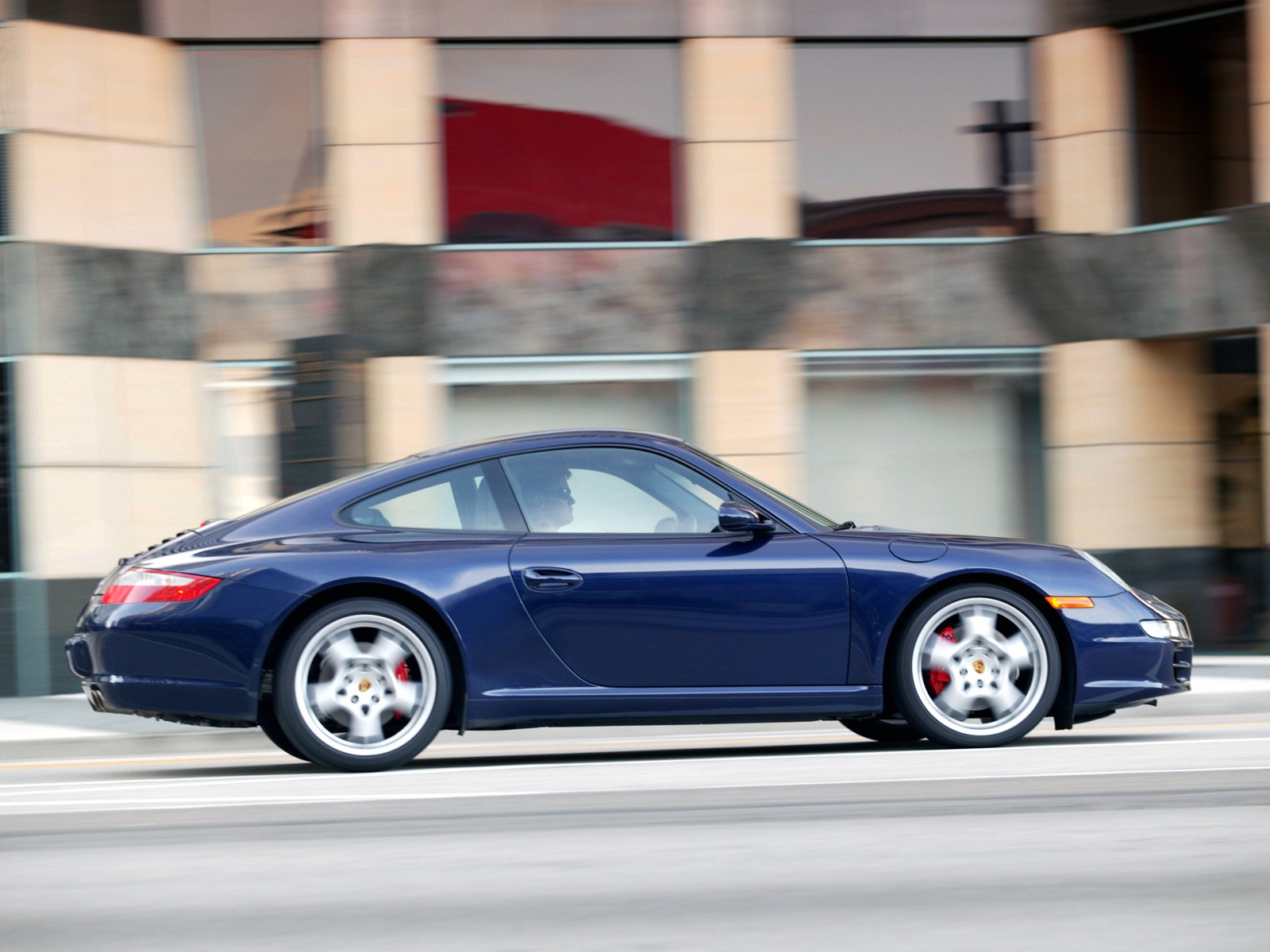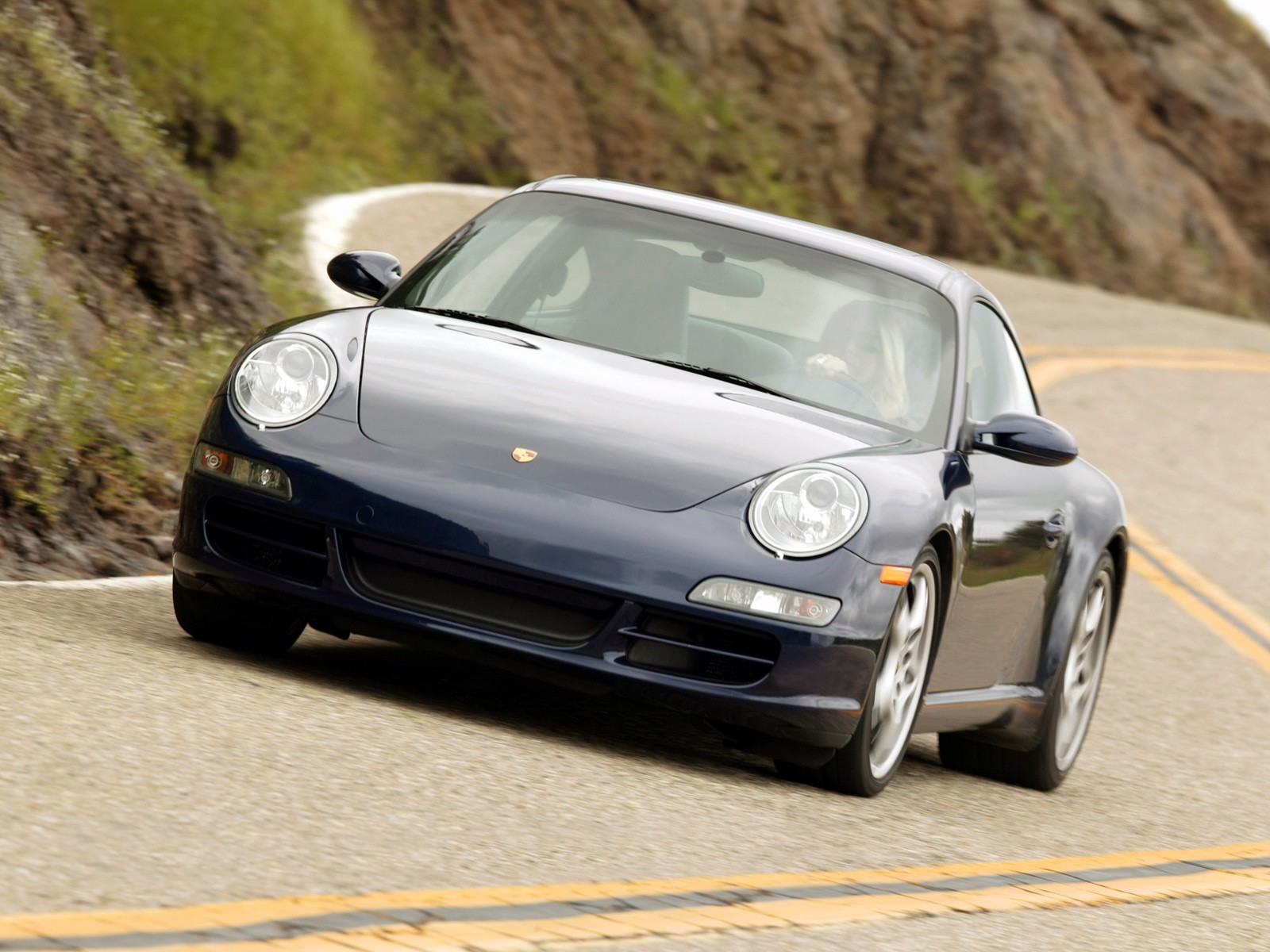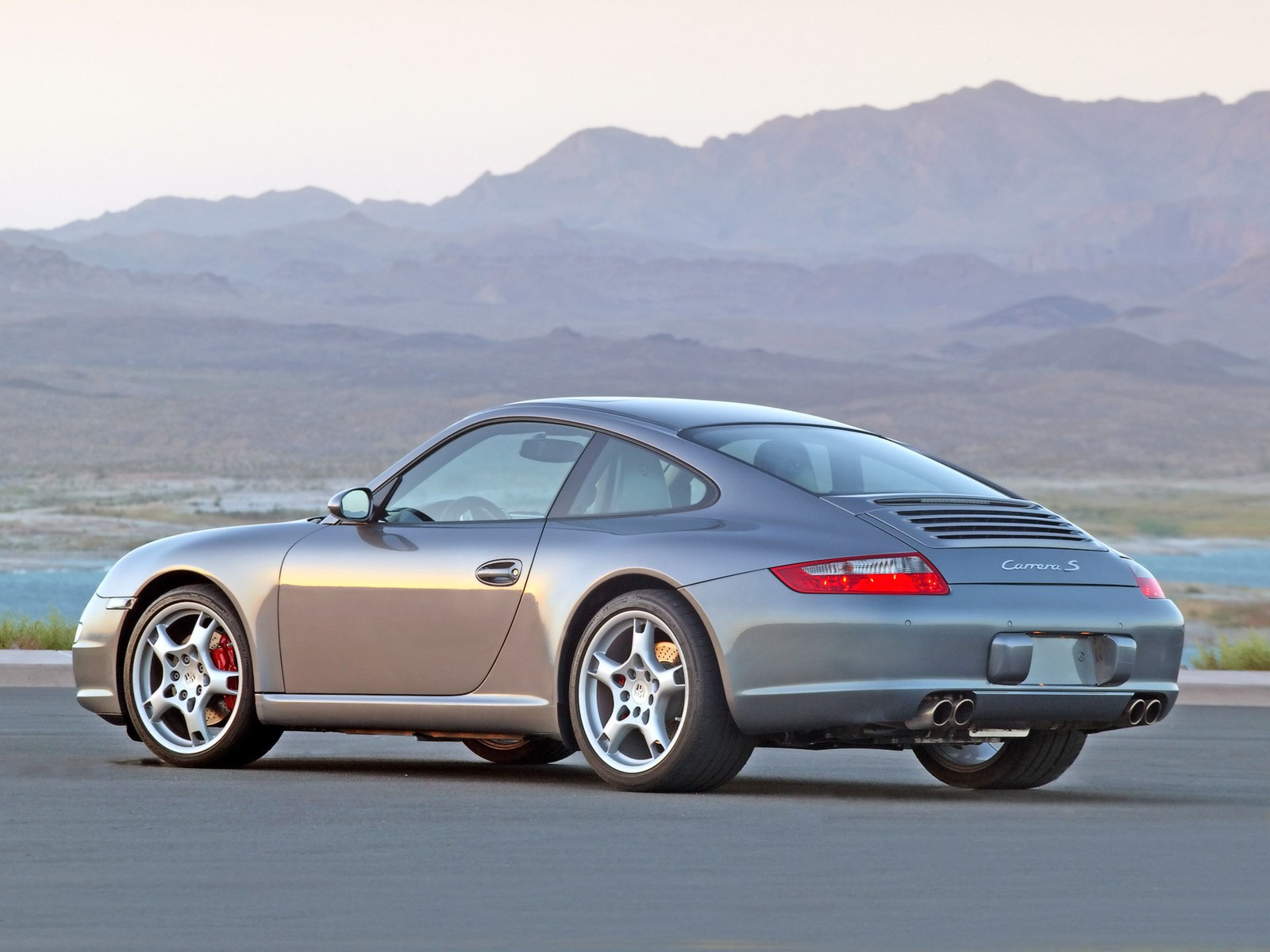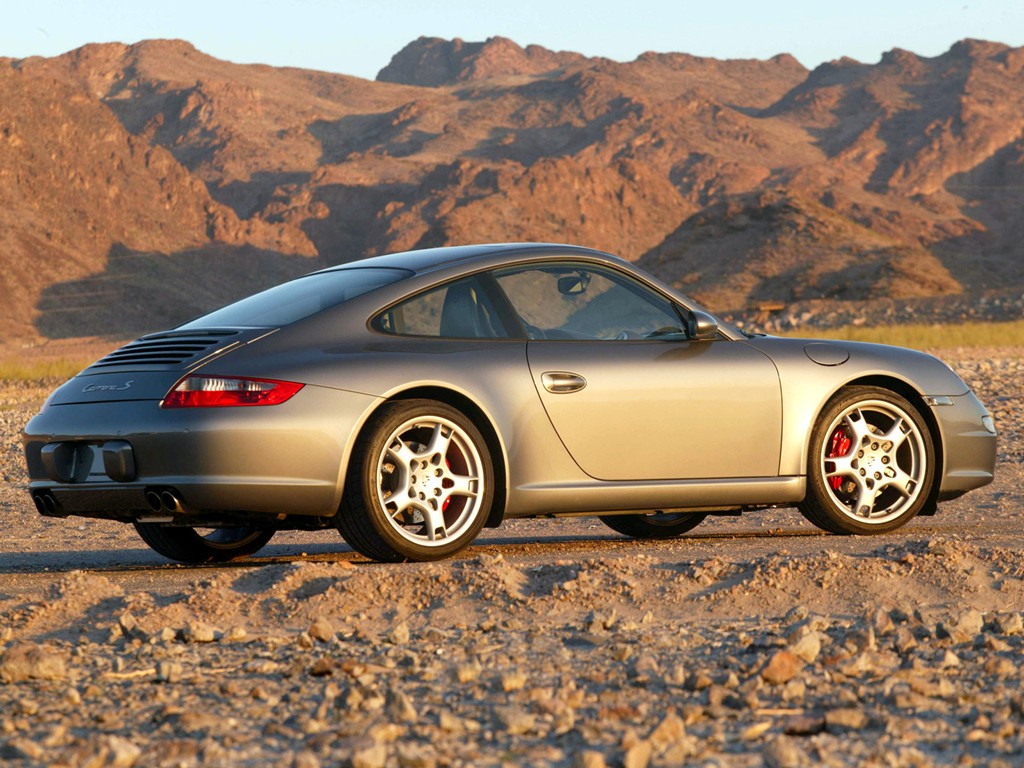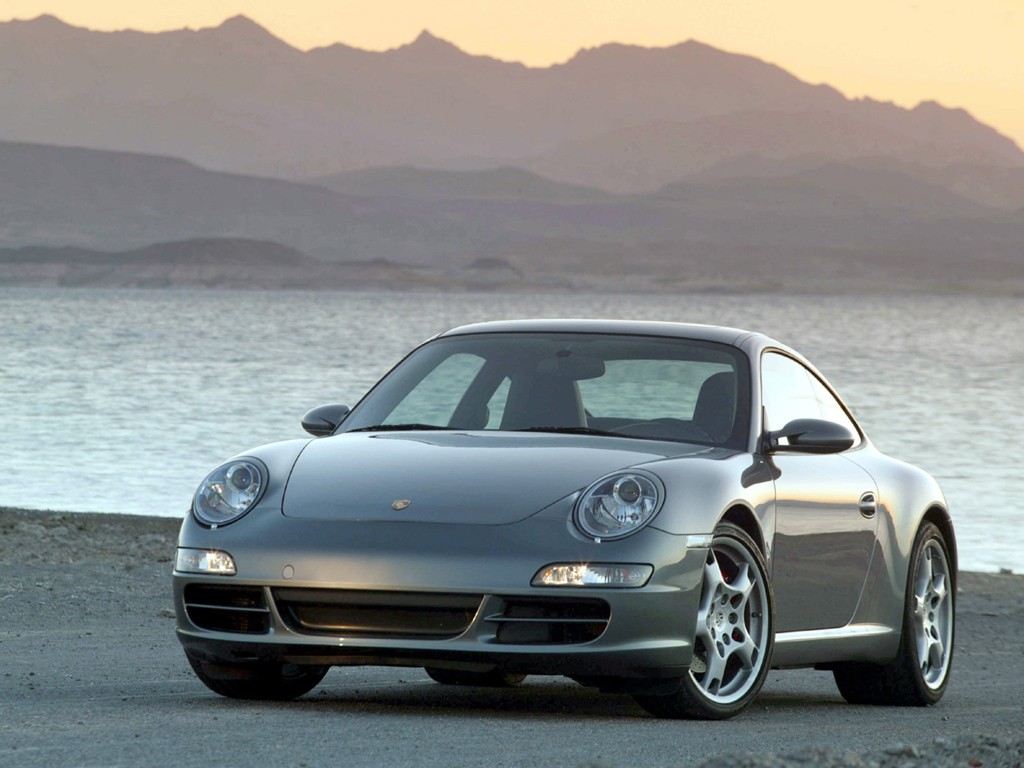(2005 – 2008) Porsche 911 Carrera S Coupe – Ultimate Guide
While the base 997 Carrera coupe is a fantastic sports car and enjoyable to drive and comfortable for daily commuting duties, it is the Carrera S, with its more powerful engine and added tech that is the sweet spot for the “regular” 997 911s.
When new in 2005, the Carrera S retailed around around $80k in the U.S, and that gave you a 3.8-liter six-cylinder, delivering 355 horsepower and 295 pound-feet of torque. Besides the bigger engine, the Carrera S got the Porsche Active Suspension Management system (PASM), 19-inch wheels, bigger brakes with painted red calipers, Bi-Xenon headlights, a sport steering wheel and aluminum-look interior trim. The Carrera S Cabriolet version was similarly equipped.
The new 350-hp, 3.8-liter boxer with DOHC variable cam timing and lift employs the same two-piece aluminum block as in the base 321-hp, 3.6-liter Carrera, but with a bore increase of three millimeters, different fuel injectors, and a reshaped air-intake system for smoother flow and lustier sound quality. Torque rises as well, by 22 pound-feet to 295. There is also an available X51 Powerkit bumps power 376 hp.
The extra power over the base 997 coupe helps the 997 Carrera S sprint from a standstill to 60 mph in just 4.6 seconds and onto a top speed of 182 mph. While only marginally faster to 60 mph, the quarter mile time of 12.8 seconds is almost a half-second faster than the base model, the longer distance giving the Carrera S an advantage with that extra midrange strength. The automatic slows things down a bit, so as always we recommend you opt for the manual gearbox.
Car and Driver said of the 997 Carrera S:
In every gear the big six whirls to about 5000 rpm, where it changes to the deep-lift cam and lunges with extra ferocity at the 7200-rpm redline. The last gear stretches to 179 mph…The old 911 GT3 with 380 horses was but a 10th quicker to 60 and the mighty 415-hp 911 Turbo just 0.2 second.
The 997 isn’t an all-new car, even if every body panel except the roof has been changed. But to look at it, you might think it’s the old car with different, circular headlights. Clearly Porsche wasn’t about to let 40 years of 911 heritage disappear without a hearty tribute to past styling. The interior has been revised, with the adoption of a centre console stack very similar to the Cayenne. Steering now uses a variable rack-and-pinion set-up, the gearshift has somehow been improved and the magic wand has been waved over electronic systems such as the traction and stability control, which is now standard on all models.
A reviewer in Australia noted:
The new steering system is a little slow to react away from the straight-ahead position, but razor sharp beyond that. If anything, it gives the 911 a feel more like those before the last 996 model: a little nervous and skittish, but definitely lively and invigorating.
Grip and traction are huge, augmented by electronic traction and stability aids. The adaptive damping has two stages of operation: a solid but supple, precise ride in the softer setting, almost too sharp in firm mode. The ceramic brakes look great and have awesome stopping ability but only seem worth it if the owner plans to take to a racetrack.
The interior has a high-tech feel but the many buttons on the centre console take some learning. Our car was fitted with a “chrono” package, consisting of a stopwatch mounted atop the dashboard. It looks tacky, is hard to access, and seems superfluous. Unlike many high-end sports cars, the 911 has an endearing practicality – normal driving position, good visibility and luggage space under the bonnet and in the (tight) back seat.
In the 997, Porsche harks back to the original concept of lightweight and nimble handling, with a lot of driver feedback and strong acceleration. The 997.1 model years ran from 2005 till 2008. In 2009 (late 2008 in Europe), the updated Carrera S (known as the Carrera S 997.2) became available, it being an evolution of the 997.1 Carrera S, the engine remained at 3.8 liters, but now produced more power while the rest of the car got some nice updates too.
Pictures
Press Release
The all-new Porsche 911 launches with a pair of coupes that package innovative technology, more powerful engines, enhanced aerodynamics and new interiors beneath a familiar and legendary silhouette.
The introduction of the 2005 Porsche 911 Carrera and the 2005 Porsche 911 Carrera S also marks the first time since 1977 that Porsche powers the 911 with a pair of engines. The 2005 Porsche 911 Carrera is propelled by a 3.6-liter flat six-cylinder engine with 325 (SAE) horsepower and 273 poundfeet of torque (370 Newton meters) while the 2005 Porsche 911 Carrera S draws on a 3.8-liter flat six that provides 355 (SAE) horsepower and 295 pound-feet (400 Nm) of torque.
S designates special Porsche models
An “S” designation has a very special meaning at Porsche, signifying a unique model, not a mere trim upgrade or option package.
The first Porsche to wear an “S” badge was the 1952 356 equipped with the 1.5-liter “Super” engine. Perhaps the most famous “S” model in the company’s history was the 911 S launched in 1967, though modern Porsche enthusiasts might tell you their favorite is the 911 Carrera 4S. In recent years, Porsche has offered higher-performance models of the Boxster roadster and Cayenne sport utility vehicle designated as the Boxster S and Cayenne S.
The larger and more powerful new 3.8-liter engine is only one of several features that distinguish the 2005 Porsche 911 Carrera S, which also comes with, as standard equipment, the new Porsche Active Suspension Management technology, larger brakes with red-painted calipers, larger wheels, Bi-Xenon headlights, a sports steering wheel, aluminum-look interior trim and a silver-colored rear deck lid logo.
Extensive list of new features
The 2005 Porsche 911 Carrera and 2005 911 Carrera S launch a new generation of the Porsche 911. While retaining the 911 badge and the same basic silhouette, the new model succeeds the previous 911, a car launched as a 1999 model and the first 911 powered by a liquid-cooled version of Porsche’s highly acclaimed flat-six engine.
The 2005 Porsche 911 Carrera and 2005 Porsche 911 Carrera S may look similar to the 911s that came before, but they are clearly new models inside and out.
Among the features unique to the new 911 are a new six-speed manual transmission, variable-ratio rack-and-pinion steering, Porsche Active Suspension Management, a Sport Chrono Package Plus that records and displays lap times, new seating options in a redesigned passenger compartment and airbags that emerge from the side window sills offering improved head protection.
Wider track, and a slimmer, more accentuated waistline
With a wider track and slimmer, more accentuated waistline, the new Porsche 911 has a more powerful and athletic stance. These characteristics are more than cosmetic changes; the car is more powerful and has an expanded envelope of dynamic capabilities compared to its predecessor.
While the wheelbase remains 92.5 inches (2,350 mm) and overall length and height are increased by less than two-tenths of an inch compared to the previous 911, the 2005 Porsche 911 Carrera rides on front and rear tracks that are nearly an inch wider than on the previous model. The numbers for the new car are 58.5 inches (1,486 mm) for the front track, compared to 57.7 (1,465) last year, and 60.4 inches (1,534 mm) for the rear track, compared to 58.3 inches (1,500 mm). Overall width of the 2005 Porsche 911 Carrera is nearly 71.2 inches (1,808 mm), almost an inch and half wider than the previous generation.
Wider, lighter suspension
But not only has the track (the width of the car’s contact with the pavement) been expanded, the suspension itself has been widened, by nearly 1.2 inches (30 mm) in front and by more than 1.3 inches (34 mm) in the rear, and has been re-engineered to enhance ride and handling characteristics.
With both performance and safety in mind, Porsche engineers redeveloped the front axle subframe, widening the structure and widening the axle pivot points by 1.18 inches (30 mm). To reduce weight and to improve airflow to the brakes, new hollow front axle pivot bearings replace solid components and reinforced and larger diameter wheel mounts are used. To enhance ride comfort, hydraulic suspension mounts are used, suppressing high-frequency vibration and minimizing the transmission of unwanted vibrations to the steering system.
In the rear, the axle has been widened by 1.34 inches (34 mm) and the multi-arm axle and its aluminum sub frame are made of more rigid components. However, the subframe also is lighter by approximately 2.2 pounds (1 kg). Porsche engineers also moved the pivot points of the upper track control arms up by 0.39 inches (10 mm) and moved the pivot points of the lower arms down by 0.20 inches (5 mm), increasing the anti-squat effect by 25 percent providing better support of lateral forces and assuring directional precision in turns.
Also new is a hollow-cast aluminum wheel mount that is 10 percent lighter but also stiffer than the former solid component.
Anti-roll bar pivot points have been changed to provide more direct response, reduce body roll in turns and reduce friction, which enhances the sensitivity of new aluminum springs that are some 70 percent lighter than conventional steel springs.
Instead of steel and rubber, rear suspension mounts use internal elastic foam that reduces weight by 45 percent and improves noise and vibration control.
Enhancing the performance of the 2005 Porsche 911 Carrera suspension system is a new generation of tires designed to convey higher forces in both longitudinal and lateral acceleration.
Porsche Active Suspension Management
Standard on the 2005 Porsche 911 Carrera S and optional on the 2005 Porsche 911 Carrera is the new Porsche Active Suspension Management (PASM). PASM uses active damping to provide two suspension systems in one, one designed for an athletic yet comfortable ride and the other for performance driving situations.
By pressing a button on the center console, the driver can switch from “PASM Normal” to “PASM Sport.” Even in normal mode, the PASM suspension lowers the car by 0.39 inches (10 mm) compared to the standard 911 Carrera suspension setup. When switched into its sport setting, PASM activates a firmer damper control map to provide extreme agility and dynamic control that minimizes body roll.
In testing at Germany’s famous Nürburgring racing circuit, the PASM Sport setting produced lap times an average of five seconds faster than with the standard 2005 suspension setup.
There are advantages to PASM even when left in its normal setting, because it automatically adjusts to changes in driving style, gradually becoming firmer to respond to greater dynamic forces.
The PASM system combines continuously adjustable shock absorbers, a pair of accelerometers – one in the front right damper dome, the other in the left rear – that determine vertical movements of the car’s body and an electronic control unit that also has access to steering angle, road speed, brake pressure and engine torque figures. Together they can provide optimum damper control for each wheel through the active dampers that have a similar structure as standard shocks (providing damping with oil pressure), but that also have a bypass valve that opens and closes to increase or reduce the oil flow as needed. (Should the system fail, the bypass valve automatically closes, putting PASM into its hardest position to assure a safe driving mode.)
Settings for any driving situation
PASM is equipped with five special software modules – lane change, vertical control, lateral acceleration, brake and load change – to provide optimum settings for any driving condition.
Lane change module: In response to rapid movements of the steering wheel in a sudden maneuver, the system instantaneously increases damper forces on both axles, reducing any tendency toward swaying or rocking.
Vertical control module: In the normal program, damper forces increase whenever vertical movement of the car’s body exceeds a threshold, for example, when driving on a bumpy surface. This reduces any risk of the body starting to rock. However, when in the sport program, the system reduces the damping effect to maintain wheel contact with a rough surface, reducing the risk of the car “jumping” around.
Lateral acceleration module: In the normal program, damping varies through a curve and adjusts with road speed and lateral acceleration.
Brake module: As soon as the driver applies the brakes, PASM firms damping to reduce body dive, ensuring faster transmission of brake forces to the road. Then, at a certain point in the braking process, the system switches to softer damping, with different forces applied in the front and rear of the car. This ensures better surface contact and shortens stopping distances, even on rough roads.
Load change module: In all-out acceleration, with the driver lifting off the accelerator while shifting gears, the control maps are adjusted for the front and rear axles. In the normal mode, harder damping is used briefly to prevent too much squat. In the sports mode, a softer damper response is used to improve traction, for example, on a rough road surface.
Larger wheels and tires
For the first time in its history, the Porsche 911Carrera rides on standard 18-inch wheels. The lightalloy rims have a five-spoke design and are produced through a new flow-forming process. They are eight inches wide on the front axle and 10 inches wide on the rear. Tires are Z-rated radials, 235/40 aspect in front and 265/40 in the rear.
The 2005 Porsche 911 Carrera S comes on standard 19-inch wheels, eight inches wide in front and 11 inches in the rear. Again, tires are Z-rated radials, 235/35 aspect in front and 295/30 in the rear.
No spare tire
Because of improved tire technology, and to reduce the weight of a spare, jack and tools (some 22 pounds or 10 kg), the 2005 Porsche 911 Carrera dispenses with those accessories and replaces them with tire sealant and electric air compressor, allowing emergency repair of a small puncture and the ability to drive at speeds of up to 50 mph (80 km/h) for short distances without damaging the wheel.
Reinforced brakes on Porsche 911 Carrera S
The 2005 Porsche 911 Carrera stops with the sort of certain authority that characterizes the dynamics of all Porsche vehicles. The new sports car has 12.51-inch (318 mm) front rotors and 11.77-inch (299 mm) rear rotors, all cross-drilled and inner-vented with black-colored, monoblock, four-piston calipers. This is the same hardware found on the 2004 Porsche 911 Carrera, except that the power of the brake servo has been increased by 17 percent to 4.5:1, reducing the force needed on the pedal and providing more spontaneous braking response.
Brake cooling also improves for 2005, thanks to the new front axle pivot mounts and enhanced undervehicle airflow.
The 2005 Porsche 911 Carrera S has even larger brakes: reinforced four-piston monoblock redpainted fixed calipers front and rear with 13-inch (330 mm) front and rear discs and larger brake pads.
Porsche Ceramic Composite Brakes
For the first time, Porsche Ceramic Composite Brakes are available on the 911 Carrera and 911 Carrera S. Previously, they were available only on special models, such as the Porsche 911 Turbo.
Instead of metal, the 13.78-inch (350 mm) brake discs are a ceramic composite material that provides high and consistent levels of friction during application. They also weigh approximately 50 percent less than metal discs and thus reduce unsprung masses by 34.4 pounds (15.6 kg) per vehicle.
Ceramic brakes help reduce brake pad abrasion compared to metal brake discs because of the extremely hard surface of the ceramic discs and because ceramic discs cannot corrode and are not affected by elements such as road salts used in winter months.
For 2005, the Porsche Ceramic Composite Brakes are more rigid, yet include more interior cooling ducts. Fiber reinforcement on the friction surface is increased, significantly enhancing resistance to abrasion under high loads.
New generation of Porsche Stability Management
The introduction of the 2005 Porsche 911 Carrera and 911 Carrera S also marks a new generation of Porsche Stability Management (PSM).
Launched on the 1999 Porsche 911 Carrera 4, PSM uses data from several sensors to detect a loss of grip and reduces instability by applying braking to individual wheels and, if necessary, by reducing engine torque.
For 2005, PSM benefits from new anti-lock brake sensors that take their readings not from conventional wheel pulses but from multi-pole seats fitted directly on the wheel bearings. These improved signals allow more precise processing and control. Instead of conventional shaft valves, linear solenoid valves adjust brake pressure with nearly infinite precision.
To provide pressure more quickly, a new hydraulic pump is used and a pre-charging pump and its connections are eliminated, reducing system weight by 25 percent or 6.6 pounds (3 kg).
Another enhancement to PSM for 2005 gives the enthusiast driver more control over the system. PSM can be turned off through a switch on the dashboard. In the past, PSM automatically reactivated when the brake pedal was depressed, but for 2005 the system reactivates only when the pedal is pushed hard enough to exceed the ABS control threshold on at least one front wheel. This change allows the enthusiast driver more dynamic freedom, including slight use of the brakes in curves.
New variable-ratio steering
For the first time, the 911 comes with standard variable-ratio steering that enhances the car’s agility on winding roads while retaining exceptional stability at higher speeds.
When the steering wheel is turned within 30 degrees of its centered position, the steering ratio remains similar to that on the previous generation 911. This helps to assure a smooth and calm driving experience, even on rough surfaces on which a driver might have a tendency to steer too much.
However, when the steering wheel angle exceeds 30 degrees from center the steering ratio become more direct, reducing the lock-to-lock ratio from its usual 2.98 to only 2.62. This gives the driver better control both on fast, winding roads and in slow-speed parking maneuvers.
In addition to the new variable ratio technology, the 2005 Porsche 911 Carrera models have steering columns that tilt and telescope to better fit each driver. The wheel can be adjusted by 1.57 inches (40 mm) both in height and reach. The steering system also includes a new electric steering wheel lock integrated into the car’s anti-theft immobilizer system.
Improved aerodynamics
In addition to enhanced suspension and steering systems, the redesigned body and its improved aerodynamics expand the dynamic capabilities of the 2005 Porsche 911 Carrera.
Another example of the 911’s design evolution is a new, oval-shaped headlamp set into an arching front fender with separate turn indicator and fog lamps set horizontally into the curving edges of the front bumper above redesigned air inlets.
New double-arm side mirrors and an aerodynamically optimized rear spoiler contribute to aerodynamic improvements that drop the coefficient of drag to 0.28 for the 2005 911 Carrera and to 0.29 for the 2005 911 Carrera S (compared to 0.30 for the 2004 Porsche 911 Carrera).
Mirror images enhance airflow
The mirrors, similar in design to those on the Porsche 911 Carrera GT supercar, guide air along the side of the car toward the rear spoiler. This reduces turbulence that might otherwise result in wind noise inside the vehicle’s cabin. At the same time, the mirror design helps keep dirt and moisture off the side windows. The mirror casing and double-arm design increases downforce on the front axle and, by channeling air toward the rear spoiler, increases positive forces on the rear axle as well.
Less lift, better grip
Also improved are the coefficient of lift numbers, to 0.05 in front and to 0.02 at the rear. The flow of air used to provide engine cooling also improves by some 20 percent. Air leaving the front radiator flows sideways into the wheel arch rather than downward in front of the wheels. This reduces losses in the airflow ducts and minimizes lift effects on the front axle.
Grip also improves because smoothing the surfaces and enhancing the design of transitional areas beneath the front of the cars create a low-pressure area that increases downforces on the front axle.
Rear spoiler: Up at 75, down at 50
The rear spoiler deploys (moves up and into position) at 75 mph (120 km/h) to enhance vehicle stability at higher speeds. Because aerodynamic forces are less significant at low speeds, the spoiler moves down again when speed drops to less than 50 mph (80 km/h).
Better aerodynamic cooling effects
Special ram-air flaps around the engine fan also boost cooling airflow without having to enlarge the air scoop openings. At low speeds, the flaps remain closed and air is drawn only through the heat exchanger, but at around 50 mph (70 km/h), the flaps open under ram pressure and provide enhanced cooling.
New undertray cover
Special air ducts on the vehicle’s new, longer and smoother undertray cover helps to direct cooling airflow to the brake discs, transmission and differential. The cover itself significantly reduces air resistance and lift.
Wheel spoilers are used to reduce drag by guiding air around the wheels. Optimized brake air spoilers and pivot bearings ensure effective air around the discs, reducing brake disc temperatures by some 10 percent.
While not changing aerodynamics, a new aluminum front trunk lid reduces weight of that element by 40 percent, or nearly 13.2 pounds (6 kg).
Taut, toned styling cues
From a side view, fenders are more muscular and wheel arches are more accentuated. Doors are inset with more pronounced lower sills. Improved sealing allows a slimmer cross-section for windshield, side and rear window elements and enhances the overall appearance of the greenhouse detailing.
The rear view of the car features flared wheel wells and wide, brilliantly lit, red and silver tail lamps on either side of the engine cover. Distinctive air scoops built into the rear spoiler and higher mounting of the third brake light emphasize the enhanced power of the rear-mounted Porsche 911 engines. In addition, the rear window wiper mounts directly to the glass and has an enhanced, aerodynamic design.
Visually pleasing engine compartment
The detail of the design of the 2005 Porsche 911 Carrera and 2005 Porsche 911 Carrera S extends all the way into the engine bay. To better showcase the flat-six engines, their lines and hoses have been rearranged and bolts and connections have been redesigned to provide a more consistent and visually pleasing engine bay. A silver placard on the air filter housing proclaims the size of the engine, and a silver-colored intake manifold further distinguishes the 3.8-liter powerplant in the Porsche 911 Carrera S.
Tailpipes are distinctive
To distinguish the 2005 911 Carrera and the 2005 911 Carrera S from behind, the S model has twin round tailpipes on either side while the 911 Carrera has a pair of oval-shaped exhaust pipes.
The tailpipes are part of an all-new exhaust and catalytic converter designed to make the 2005 Porsche 911 Carrera and 2005 Porsche 911 Carrera S even cleaner. The 911 Carrera S is equipped with an exhaust manifold with much shorter individual pipes designed to lower cold-start emissions from this more powerful engine.
Both cars use the same two-stage “cascade” style catalytic converter designed to reach operating temperature more quickly and efficiently.
The new system reduces exhaust emissions some 15 percent compared to the 2004 911 Carrera. Advanced thin-wall technology also makes the new exhaust system 12.1 pounds (5.5 kg) lighter than the previous hardware.
More powerful 3.6-liter engine
Exhaling through the new exhaust system are the 2005 Porsche 911’s 3.6- and 3.8-liter flat-six engines.
While the 3.6-liter engine in the 2005 Porsche 911 Carrera is familiar, fine-tuning, especially of the air filter, has increased output by 10 horsepower. Torque remains at 273 pound-feet (370 Newton meters) at 4250 rpm.
The engine propels the 2005 Porsche 911 Carrera from a standing start to 62 mph (100 km/h) in 5.0 seconds, to 100 mph (160 km/h) in only 11.0 seconds and to nearly 125 mph (200 km/h) in 17.5 seconds. The car can complete a standing kilometer sprint (.62 miles) in 23.8 seconds.
Crucial to the engine’s performance is Porsche’s patented VarioCam Plus valve management technology that combines camshaft control on the intake side with variable valve lift. VarioCam Plus adjusts camshaft position to provide continuously adjustable valve timing and also incorporates two camshaft profiles and two sets of tappets to vary valve lift and duration. This system helps to both “fatten” and smooth the torque curve while reducing emissions.
To provide optimum oil flow through the alloy engine block and cylinder heads, Porsche uses integrated dry sump lubrication and three oil pumps – one in the crankcase and additional pumps within each cylinder head, thus assuring proper lubrication despite the forces of hard acceleration, braking or cornering.
For 2005, the oil pump on the 4-5-6 cylinder head is combined with a pneumatic vane-cell pump to provide necessary vacuum for the brake servo as well as the engine and transmission control systems. This technology greatly reduces hydrocarbon emissions following a cold start and engine warm-up.
While more powerful, the engine also is lighter, by some 4.4 pounds (2 kg), through the elimination of an oil dipstick (oil level is monitored electronically every time the car is started), lower weight of the cylinder head, cup tapped housing and cylinder head cover and weight reductions within the cooling system.
3.8-liter engine for Porsche 911 Carrera S
To create the more powerful 3.8-liter engine that provides 355 horsepower for the 2005 Porsche 911 Carrera S, engineers did more than simply increase the bore diameter by 0.11 inches (3 mm). They also changed the intake manifold and modified the intake camshaft lift pattern. Injector angles have been changed, assuring that more fuel goes to the center of the combustion chamber in the intake stroke. This means an even better fuel/air mixture, reduced exhaust emissions (even after a cold start) and more torque than the 3.6-liter engine throughout the power curve.
The engine provides an impressive 77.1 pound-feet per liter (104.6 Newton meters). Performance figures include 0 to 62 mph in 4.8 seconds, 0 to 100 mph in 10.7 seconds and 0 to 125 mph in 16.5 seconds. The car can sprint one kilometer from a standing start in just 23.4 seconds. For confident passing, the engine provides such strong torque that even in fifth gear the 911 Carrera S accelerates from 50 to 75 mph (80 to 120 km/h) in just 6.1 seconds.
The entire intake system was redesigned and provides smoother flow with less resistance.
A Helmholtz resonator is used to refine acoustics. This provides more than 18 cubic inches (0.3 liters) of additional resonance volume between the hot-film air mass meter and the throttle butterfly and is activated between 5,000 and 6,000 rpm to reduce oscillations in intake sounds. Porsche has applied for a patent for this technology that provides a deep, throaty sound without aggressive peaks.
Higher combustion forces produce more power but also more torsional crankshaft vibration, so Porsche engineers have integrated a vibration damper in the pulley at the end of the crankshaft. Conventional vibration dampers are made of cast iron but Porsche engineers devised an aluminum damper that reduces weight by some 3.3 pounds (1.5 kg) while controlling vibrations to a level even lower than the 3.6-liter engine.
Amazingly, the 3.8-liter engine weighs no more than the 3.6-liter unit thanks to its lighter intake manifold and weight optimization within the cylinder head.
While the 3.8-liter engine uses twin radiators like the 3.6-liter powerplant, it has a higher performance cooling pump and an oil/water heat exchanger with two additional cooling layers.
New six-speed manual transmission
To deal with the new engine’s 295 pound-feet of torque (400 Nm), Porsche developed a new sixspeed manual gearbox that is used in the 2005 Porsche 911 Carrera and the 2005 Porsche 911 Carrera S.
The transmission has thicker shafts and wider gears but weighs no more than the previous manual gearbox. Extra-thin aluminum used for oil chamber walls saves weight and reduces splash effect and flow losses and increases the efficiency of the gearbox.
Even though gear ratios have been reduced by around 5 percent, the use of larger rear wheels results maintains the overall transmission ratio and allows the car to reach top speed in sixth gear just before maximum engine speed is achieved.
While brass synchronizing rings were formerly used, the new transmission has steel rings in all gears and thus can handle higher power loads. For the first time Porsche uses wear-resistant carboncoated first, second and third-gear synchronizing rings, and boosts from double to triple synchronizing for first and second gears and from single to double for third gear, retaining single synchronizing for gears four, five and six.
The driver will notice this change in the reduced forces and shorter travel needed to change gears. Shifter travel is reduced by some 15 percent. Shifting also is smoother and more precise because of relocation of the shift lever pivot point and lower-friction shift cables.
Porsche’s single-disc dry clutch with lead-free pads is retained for the 2005 Porsche 911 Carrera while the 2005 Porsche 911 Carrera S gets a new self-adjusting clutch.
Enhanced Tiptronic S available
Tiptronic S is Porsche’s optional automatic transmission that allows manual gear selection through either the lever on the floor console or via switches on the steering wheel. The five-speed unit allows the driver to use the thumb switches to change gear momentarily, for example, for passing or to downshift for a curve, even while the floor lever remains in its automatic position.
Several modifications have been made to Tiptronic S in conjunction with the increased torque produced by the 3.8-liter engine in the 2005 Porsche 911 Carrera S.
To provide quicker response in full acceleration from a standing start, stall speed has increased so the converter lock-up clutch is closed and power flows more smoothly. Instead of making the first-second shift at 6,900 rpm under full power acceleration, Tiptronic S now holds first gear until the engine achieves 7,200 rpm.
In addition, the oil pressure build-up has been fine-tuned and clutch plates modified to allow the Tiptronic S to shift more smoothly. New lubricating fluid not only reduces friction but also extends the transmission fluid change interval from 100,000 miles (160,000 km) to 112,000 miles (180,000 km).
Throttle tip-in mimics enthusiast’s driving technique
To mimic the way an enthusiast driver manipulates the accelerator, brake and clutch, changes to the engine management software produce a slight boost in engine speed during aggressive downshifting. This shortens shift time and enhances gearshift mesh.
The PSM OFF function has been modified so that when the Tiptronic S selector lever is in its manual mode and the PSM OFF switch is activated, the transmission will not shift up even when the engine reaches the rev limiter. This allows the enthusiast driver to drive with the engine near its rev limit while maintaining the selected gear.
As with the six-speed manual transmission, a shorter gear ratio works in conjunction with the larger standard rear wheels to achieve maximum top speed in the top (fifth) gear.
To keep the enhanced Tiptronic S operating at proper temperatures, the gearbox is equipped with an additional oil/water heat exchanger with two additional cooling layers and with a more powerful coolant pump.
Redesigned interior
The interior of the 2005 Porsche 911 Carrera and 2005 Porsche 911 Carrera S has been completely redesigned with new steering wheels, seats, gauge cluster, improved climate control, standard Porsche Communication Management (with available DVD navigation system), updated audio, upgraded anti-theft system, six standard airbags and the new Sport Chrono Package Plus option.
New steering wheel design
The standard steering wheel in the Porsche 911 Carrera and 911 Carrera S has a new and more dynamic three-spoke design and is adjustable both in height and reach. In keeping with the engineering theme of lightweight technology, the new wheel is supported by a composite magnesium structure that reduces the weight of the steering wheel assembly by 10 percent compared to the former steel and aluminum structure.
Multifunction wheel on Porsche 911 Carrera S
For the first time, a multifunction steering wheel is available on the Porsche 911 Carrera and the 911 Carrera S. This wheel allows the driver to operate audio, navigation and telephone equipment via controls mounted on the steering wheel.
A rotary knob on the left-hand steering wheel spoke controls audio volume, which can be muted by pressing the knob. A knob on the right-hand spoke accesses menu points on the Porsche Communication Management (PCM) system. Pressing the knob selects individual items. The two buttons on the lower steering wheel arm control the telephone.
In addition to the standard leather colors that match the rest of the interior, the multifunction steering wheel is available with wood grain or carbon trim.
More supportive seats are lighter and stronger
A new seat design for the 2005 Porsche 911 Carrera and 911 Carrera S includes a patented system engineered to better absorb vibration and thus help keep the driver and front-seat passenger fresh and alert even on long trips. To better accommodate taller occupants, the shoulder area and width of the seat cushion have been increased. To accommodate taller drivers, the pedals have been moved 0.39 inches (10 mm) toward the front of the car.
The seats also feature higher side bolsters to provide support in situations of higher lateral acceleration through curves.
To help lower the car’s center of gravity, the seats are mounted 0.39 inches (10 mm) closer to the floor, providing the driver with a more dynamic seating position while also creating more headroom for taller occupants.
Again, lightweight technology has been employed in the seat structure, which is stronger and more stable while being some 6.1 pounds (3 kg) lighter for each of the front seats.
Four seating options
The standard front seats are adjustable in six directions – fore and aft, height and backrest angle. Height adjustment is made through a new mechanical step function positioned between the seat and the doorsill. Backrest angle is electrically controlled.
All-electric seats are available and adjustable in 12 directions, including the angle of the seat cushion and a lumbar support comprising four air chambers. These seats also have a memory feature.
Sport seats with even greater lateral support both in the seat cushion and shoulder area also are available. These seats also feature firmer padding.
Adaptive sport seats provide a fourth variation. They combine the sports design with electrical controls. These seats have four-dimensional adjustment that includes adjusting the width to fit the occupant.
Larger instrument display
The five dials that comprise the instrument panel have been moved farther apart to provide a larger display area for better readability. The faces of the dials are black in the Porsche 911 Carrera and have an aluminum finish in the Porsche 911 Carrera S.
The tachometer remains the large and center dial and continues to have a digital display beneath the rev counter. The speedometer with integrated overall and trip odometers is just to the left of the tach while large gauge just to the right of the tach includes coolant temperature and fuel gauges as well as the clock. The oil temperature gauge is at the far left of the cluster with the oil pressure gauge at the far right.
The new gauges have white light-emitting diodes that enhance illumination for night driving.
Sport Chrono Package Plus
A clock-style gauge mounted on top of the dashboard is part of the optional Sport Chrono Package Plus available on 2005 Porsche 911 Carrera and 2005 Porsche 911 Carrera S.
The “Chrono” option allows the driver to engage more aggressively set electronic control maps for the Motronic engine management system, Porsche Stability Management (PSM), Porsche Active Suspension Management (PASM) and Tiptronic S transmission (on vehicles equipped with these options).
The revised Motronic maps strongly favor performance over comfort and provide even quicker engine response, not only on deployment but also release of the throttle, as well as more abrupt gearshifts by the Tiptronic S transmission. PSM thresholds, including ABS settings, expand to allow more lateral slip before intervention. PASM switches to its firmer setting to provide more agility in cornering. However, in some instances, such as on wet pavement, a softer suspension setting can be advantageous so the driver using the “Chrono” package simply presses the PASM button to return to the normal damper settings.
The Chrono Package Plus includes a digital/analog stopwatch and lap-counting function (activated by a button on the stalk on the left side of the steering column) and uses the screen of the Porsche Communication Management (PCM) for graphic display and review for this information.
Revised heating, air conditioning and ventilation
To help keep the driver and occupants cool in all situations, the 2005 Porsche 911 Carrera and 911 Carrera S feature automatic climate controls with an interior air and pollen filter. The air guidance system has been revised with larger pipes and side vents to improve the output and performance of the air conditioning system.
Climate controls are integrated into the center console along with switches for seat and rear window heating.
Standard PCM with upgraded audio equipment
Revised Porsche Communication Management (PCM) is included as standard equipment in both 2005 Porsche 911 Carrera and 911 Carrera S models. New features for PCM include a DVD-based navigation system as separate optional module located in the luggage compartment. This allows the CD drive on the PCM to be used exclusively for audio CDs.
The upgraded and DVD-based optional navigation module is much faster than the former CD-based system and allows rapid availability of routes and map updating, as well as 23 zoom stages up to a minimum resolution of some 55 yards (50 meters).
Also standard on PCM is a new Sound Package Plus that includes nine speakers with three times the usual transmission area and with an external analog amplifier for outstanding sound in all driving conditions. The system includes two 19-mm tweeters and one 70-mm mid-range speaker in the instrument panel, two 100-mm midrange speakers and two 200-mm woofers in the doors and a 100- mm wide-band speaker in the rear section of the passenger compartment.
The external analog amplifier is located in the luggage compartment and supplies the woofers in the doors and the midrange speakers in the instrument panel.
A multiple CD changer is available as an option; Pre-wiring is installed in all 2005 Porsche 911 Carrera and 911 Carrera S models for easy installation of a CD changer in the luggage compartment.
Optional Bose Surround Sound System
The new 911 is the first sports car available with a Bose Surround Sound System that includes 13 speakers and a seven-channel digital amplifier integrated into the MOST light wave conductor that is part of PCM.
The heart of the Bose Surround Sound System is a digital amplifier with a 5 x 25 watt output and additional support from an integrated and an external 100-watt switching terminals. Active electronic equalization adjusts the reproduction of sound to specific acoustic conditions so all passengers enjoy a sound experience.
The system includes Bose’s AudioPilot technology that automatically adjusts sound and volume to compensate for wind or road noise inside the vehicle. A special microphone in the steering column cover picks up such noises.
Speakers used in the Bose Surround Sound System are Neodym units that are more compact, lighter and have better performance than conventional speakers. A Neodym iron boron magnet generates a magnetic field 10 times more powerful than a conventional speaker magnet. These speakers also weigh some 23 percent less than the speakers used in previous 911 models.
The Bose Surround Sound speakers include two 25-mm tweeters and one 70-mm midrange speaker in the instrument panel, two 80-mm mid-range speakers and two 200-mm woofers in the doors, two 25-mm tweeters and two 80-mm midrange speakers in the rear of the passenger compartment and one active subwoofer with two 130-mm woofers in the rear parcel shelf.
Increased storage area
The 2005 Porsche 911 Carrera and 911 Carrera S feature expanded storage compartments and boxes. The capacity of the locking glove box has been increased to nearly 400 cubic inches (6.5 liters) and includes a rack to hold two CDs as well as a penholder.
Just above the glove box is a cup holder hidden behind a folding trim cover. When released, the left cup holder emerges in front of the central air nozzle in the instrument panel while the right cup holder rests in front of the front passenger nozzle.
The center console includes more than 90 cubic inches (1.5 liters) of storage capacity as well as a 12- volt outlet and a coin holder. This compartment automatically locks when the central locking system for the doors is activated.
Additional storage pockets are located in the interior door panels with covers that also serve as armrests.
Another large storage area is located behind the rear seats. Tipping the seat backs forward can expand this area.
Even the forward luggage compartment is larger, offering 4.72 cubic feet (135 liters) of storage capacity.
Cayenne-style electronic network
The 2005 Porsche 911 Carrera and 911 Carrera S benefit from a comprehensive electronic network like that introduced in the Porsche Cayenne sport utility vehicle. Thus the 911 assures complete and efficient exchange of data and electronic information by 29 control units throughout the vehicle through an internal high-speed network or CAN-bus (Controller Area Network) and light-wave MOSTbus (Media-Oriented System Transport) networks.
Without such electronic networking, features such as Porsche Active Suspension Management would not be possible. The software required for this purpose has been developed under Porsche’s leadership and represents one of the company’s core competencies.
In addition to quicker and more integrated electronic communication with a wider range of functions, this new electronic system is some 11 pounds (5 kg) lighter than the system used in the 2004 model.
New guide-me-home lighting
The exterior lighting system includes a guide-me-home feature that can be selected via the light switch. This feature turns the lights on when you leave the car. In addition to headlamps, fog lights, rear lights and license plate lights stay on for 30 seconds allowing the driver and occupants to see obstacles or puddles of water.
Impressive list of options
Included on the option lists are Porsche ParkAssist, which uses ultrasound to measure the distance and provides an audible warning to the driver, a programmable HomeLink [R] system that can open a garage door or turn on the lights in your home as well as a roof transport rack system. Porsche’s Exclusive and Custom Tailoring programs allow drivers to further personalize their vehicles.
Standard anti-theft warning system
The 2005 Porsche 911 Carrera and 911 Carrera S feature a standard anti-theft warning system that uses a new radar sensor to maintain surveillance of the vehicle interior. Unlike some systems, this sensor is not affected by reflections from bright interior leather surfaces.
Six airbags in every car
Every 2005 Porsche 911 Carrera and 911 Carrera S is equipped with six airbags, including two front and two seat-mounted side-impact airbags. In addition, the 2005 Porsche 911 Carrera and 911 Carrera S expand the Porsche Side Impact Protection (POSIP) system with the world’s first head airbag that emerges from the side window sill. These new airbags provide a flat cushion that inflates to nearly 500 cubic inches (8 liters) and provides protection of the heads of the driver and front-seat passenger from broken glass and objects that might enter through the window.
Safe by design
Due to the use of high- and ultra-high-strength steel as well as improvements in spot-welding and bonding, the 2005 Porsche 911 Carrera and 911 Carrera S body is improved by 8 percent in torsional rigidity and by 40 percent in flex resistance. However, the body-in-white is only 33 pounds (15 kg) heavier than the 2004 model, weighing in a 602 pounds (273 kg).
Particular attention was paid in the areas of the junction of the A-pillars and the roof frame, as well as the safety structure involved in head-on and offset collisions, including the transition between the door and B-pillars. Forces in a collision can be transferred through the door to the rear of the car and thus around the passenger compartment.
An upgraded bulkhead crossbar at the front of the car is made from high-strength boron 02 steel and a new assembly process to minimize possible intrusion in to the foot well in an offset collision.
Reduced cost of ownership
The new technologies, lubricants and even new lighting technology used in the 2005 Porsche 911 Carrera and 911 Carrera S extends service intervals and should contribute to a lower cost of ownership during the vehicle’s lifetime. Oil changes are now required every 20,000 miles, spark plugs should be changed at 60,000 miles and air filters now last until 40,000 miles.


